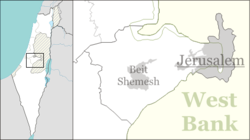Mata (Hebrew: מַטָּע, lit. 'Grove') is a moshav in central Israel. Located in the Jerusalem corridor about eight kilometers southeast of Beit Shemesh, it falls under the jurisdiction of Mateh Yehuda Regional Council. In 2022 it had a population of 951.[1]
Mata
מטע | |
|---|---|
 | |
| Coordinates: 31°43′4″N 35°3′44″E / 31.71778°N 35.06222°E | |
| Country | Israel |
| District | Jerusalem |
| Council | Mateh Yehuda |
| Affiliation | Moshavim Movement |
| Founded | 1950 |
| Founded by | Yemenite Jews |
| Population (2022)[1] | 951 |
Etymology
edit"The name mata is also hinted at in Ezekiel (XXXIV, 29)":[2] I will provide for them a grove.
History
editThe village was established in 1950 by immigrants from Yemen on land that had belonged to the depopulated Arab villages of Allar and Khirbat al-Tannur.[3][4] Initially the moshav fell under the jurisdiction of Elah Regional Council until the council was merged into Mateh Yehuda Regional Council in 1964. The moshav belongs to the Hapoel HaMizrachi stream, but today the majority of its population is secular.
Archaeology
editAlong the old Roman road (now regional highway 375) are the ruins of a travelers' inn and livery stable, now called "khanut" (formerly, Khirbet el-Khan).[5] A mosaic floor with Greek writing of a Byzantine type can still be seen in the remains of the structure, believed to have been used as a church in the 6th century.[6]
In the 12th century a rural monastery was established there by the Crusaders consisting of several barrel-vaulted buildings, an enclosure wall and a chapel.[7]
Charles Clermont-Ganneau describes the ruins of a church (el-K'niseh), partially standing, in the valley below (Wadi et Tannur), and which he thought to be of medieval origin.[8]
In the valley are various types of trees: Sweet and bitter almonds, olives, grapes, pomegranates, lemons, figs, walnuts, Syrian pears, carobs and hawthorns. To the south-east of the moshav is a natural spring called `Ain Jurish named after a nearby small Arab village (now abandoned) and which was built on the spur of a hill near the town of Tzur Hadassah (Har Kitron). Rock-carved niches used as tombs can still be seen in the abandoned village.
Landmarks
editTo the west of the moshav is Wadi Tannur, a riverine gulch with two natural springs - Ein Mata (Spring of the Orchard) and Ein Tannur.
At the foot of Ein Tannur ("Oven Spring") is an ancient tunnel dug deeply to catch the water at the source and increase its flow - a spring-flow tunnel.[9] According to a local legend, Noah's oven was located nearby before the flood. When God destroyed the world, Noah's oven began spouting water, proving Noah's great commitment to God. When the flood was over and the water subsided, the oven forgot its original purpose and water continued to flow from it. When Noah passed by in his ark, he only saw the spring rather than his oven, so he continued his journey and finally landed on Mount Ararat.[10]
Gallery
edit-
Vineyard in early Spring, southeast of Moshav Mata
-
Entrance to natural spring (now dry), Ain et-Tannur, in valley below Mata
-
Entrance to tunnel whence flowed a natural spring, now run-dry
-
A natural spring near Moshav Mata
-
Remains of caravanserai (Khan), formerly used also as a Byzantine church, near Moshav Mata
-
Caravanserai (Khan), used also as a 6th-century Byzantine church, near Mata
-
Byzantine mosaic, circa 6th-century CE
-
View of Moshav from Wadi Tannur
-
Signpost describing Roman road, near Mata
-
Old Roman road, adjacent to regional hwy 375 in Israel
-
Roman period columns, fallen along old Roman road
Further reading
edit- Shlomo Shwartz, New People in the High Mountains (אנשים חדשים בהרים הגבוהים), Hakibbutz Hameuchad, 1953 (Hebrew) - stories of the first settlers in Mata (Allar Aleph)
References
edit- ^ a b "Regional Statistics". Israel Central Bureau of Statistics. Retrieved 21 March 2024.
- ^ Place Names in Israel. A Compendium of Place Names in Israel compiled from various sources. Translated from Hebrew, Jerusalem 1962 (Israel Prime Minister’s Office. The Israeli Program for Scientific Translations) p111
- ^ Mata Home
- ^ Khalidi, W. (1992). All That Remains: The Palestinian Villages Occupied and Depopulated by Israel in 1948. Washington D.C.: Institute for Palestine Studies. pp. 266, 320. ISBN 0-88728-224-5.
- ^ See Palestine Exploration Fund Map: Jerusalem (Sheet XVII), the ruin of Khurbet el-Khan), Survey of Western Palestine, 1878 Map, Map 17: IAA Archived 2018-11-03 at the Wayback Machine, Wikimedia commons, as surveyed and drawn under the direction of Lieut. C.R. Conder and H.H. Kitchener, May 1878.
- ^ Caravanserai near Mata also served as 6th-century Byzantine church, based on Hebrew signpost at site.
- ^ Crusader Archaeology: The Material Culture of the Latin East, Adrian J. Boas
- ^ Charles S. Clermont-Ganneau, Archaeological Researches in Palestine (vol. ii), London 1896, pp. 455, 458–459
- ^ Ein Mata, Horbat Hanut and Shevil HaKeisar
- ^ Ben Yosef, Sefi (March 1, 2007). "The Oven that Became a Spring". Ynetnews. Retrieved May 19, 2019.
External links
edit- Mata in Antiquity Archaeological Survey of Israel
